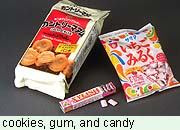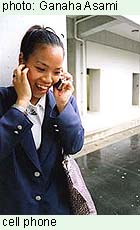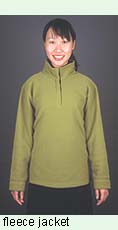
 |
  |
  |
  |
  Yu, 17, second-year, private high school, girl, Saitama prefecture The amount of the allowance I get from my parents isn't set, but they give me money for food, stationery goods, supplementary textbooks ( including drills and study guides ), and such, and probably about 2,500 yen when I need it. I have to buy whatever else I want from my  otoshidama ( New Year's gift ). I received 80,000 yen as otoshidama this year and saved about 70,000 yen. My cell phone is a family phone and my parents pay the bill, which is usually about 5,000 yen a month. otoshidama ( New Year's gift ). I received 80,000 yen as otoshidama this year and saved about 70,000 yen. My cell phone is a family phone and my parents pay the bill, which is usually about 5,000 yen a month. I spend most of my allowance on snacks -- cookies, gum, candy, drinks -- pens and paper, supplementary textbooks, and some clothing. The extra textbooks I buy are those for English, classical Japanese, etc. I don't attend extra classes at cram schools, but supplement my studies by working with these commercially available textbooks. After it got cold this winter, I bought a muffler and gloves. I also bought a fleece jacket to wear on a school trip. Clothing made of fleece fabric is lightweight and very warm, as well as inexpensive, so it is enjoying a big boom in Japan right now. Everybody around me seems to have at least one fleece jacket. I spend most of my allowance on snacks -- cookies, gum, candy, drinks -- pens and paper, supplementary textbooks, and some clothing. The extra textbooks I buy are those for English, classical Japanese, etc. I don't attend extra classes at cram schools, but supplement my studies by working with these commercially available textbooks. After it got cold this winter, I bought a muffler and gloves. I also bought a fleece jacket to wear on a school trip. Clothing made of fleece fabric is lightweight and very warm, as well as inexpensive, so it is enjoying a big boom in Japan right now. Everybody around me seems to have at least one fleece jacket.
 |
 
|
||||||||||||||||||||||||||
 Otoshidama ( New Year's gift ): Cash gifts presented to children by parents, grandparents, relatives, or family friends at New Year's. The average otoshidama of high school students is about 40,000 yen, and most students put it into savings accounts. They use it to supplement their monthly allowance or to purchase major items they want to buy.* Otoshidama ( New Year's gift ): Cash gifts presented to children by parents, grandparents, relatives, or family friends at New Year's. The average otoshidama of high school students is about 40,000 yen, and most students put it into savings accounts. They use it to supplement their monthly allowance or to purchase major items they want to buy.** Karaza Report'99 vol.3, Kumon Children's Research Institute, 1999.  Keitai ( denwa ) ( mobile phone ):
As of March 31, 2000, there were nearly 57 million users of mobile phones ( cellular or PHS )in Japan, which makes 1 phone for every two people in Japan, not counting preschoolers. About 59 percent of all high school students have cell phones, and of these 56 percent say that they feel closer to their friends as a result. On the other hand, 37 percent say they think that unnecessary phoning has increased as a result of the cell phone boom. Keitai ( denwa ) ( mobile phone ):
As of March 31, 2000, there were nearly 57 million users of mobile phones ( cellular or PHS )in Japan, which makes 1 phone for every two people in Japan, not counting preschoolers. About 59 percent of all high school students have cell phones, and of these 56 percent say that they feel closer to their friends as a result. On the other hand, 37 percent say they think that unnecessary phoning has increased as a result of the cell phone boom. The appearance of multi-function cell phones that provide Internet access and e-mail services -- the so-called i-mode phones -- has made keitai denwa indispensable equipment for keeping in touch and for ordinary communication among young people. Service charges among the high school students average from 4,000 yen to 7,000 yen. About 30 percent " pay all the charges myself," 20 percent "share payment with parents," and 30 percent " have parents pay all the charges." The appearance of multi-function cell phones that provide Internet access and e-mail services -- the so-called i-mode phones -- has made keitai denwa indispensable equipment for keeping in touch and for ordinary communication among young people. Service charges among the high school students average from 4,000 yen to 7,000 yen. About 30 percent " pay all the charges myself," 20 percent "share payment with parents," and 30 percent " have parents pay all the charges." Criticism has recently focused on the lack of consideration of some cell phone users who disturb others by talking in loud voices on their phones in public places,such as on crowded trains. Criticism has recently focused on the lack of consideration of some cell phone users who disturb others by talking in loud voices on their phones in public places,such as on crowded trains.Source: Seishoonen to keitai denwa nado ni kansuru choosa kenkyuu hookokusho [ Report of the Study on Youth and Mobile Phone Use ], Management and Coordination Agency, December 2000. |
Original text : The Japan Forum Newsletter no20 "A day in The Life" March 2001.
Send feedback to forum@tjf.or.jp
 Sample of Yu's Monthly Accounts (yen)
Sample of Yu's Monthly Accounts (yen) Supplementary textbooks
Supplementary textbooks